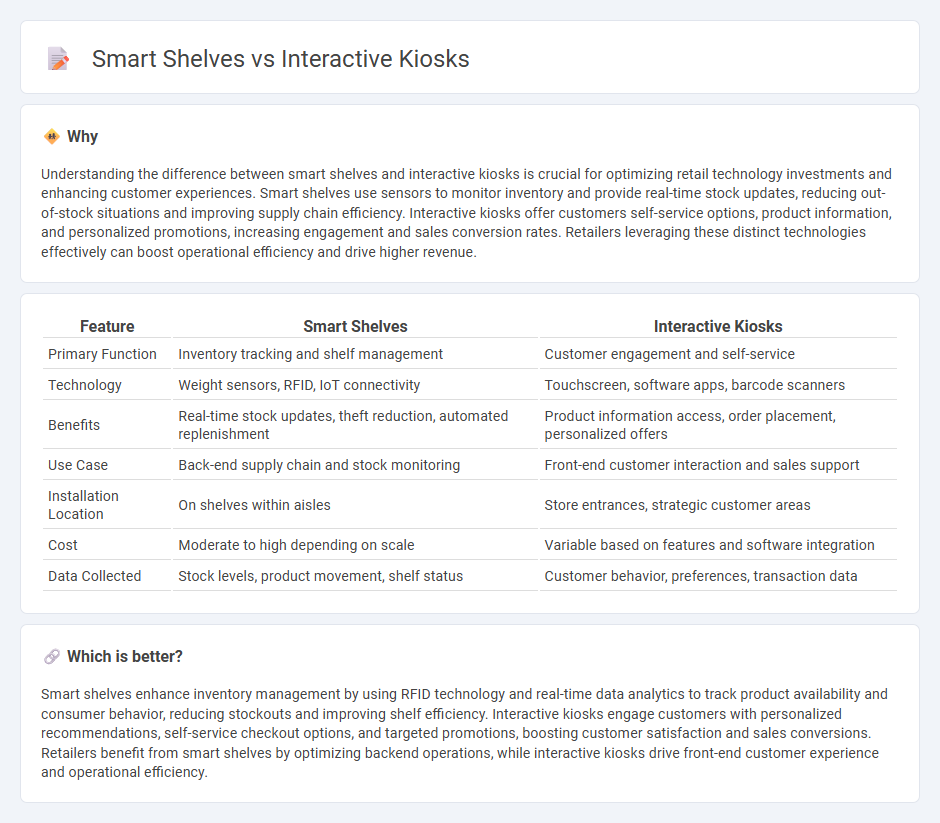
Smart shelves utilize RFID and weight sensors to monitor inventory in real-time, enhancing stock accuracy and reducing out-of-stock situations. Interactive kiosks provide personalized customer experiences through touchscreens, enabling product information access, self-checkout, and targeted promotions. Explore how these innovative technologies revolutionize retail operations and customer engagement.
Why it is important
Understanding the difference between smart shelves and interactive kiosks is crucial for optimizing retail technology investments and enhancing customer experiences. Smart shelves use sensors to monitor inventory and provide real-time stock updates, reducing out-of-stock situations and improving supply chain efficiency. Interactive kiosks offer customers self-service options, product information, and personalized promotions, increasing engagement and sales conversion rates. Retailers leveraging these distinct technologies effectively can boost operational efficiency and drive higher revenue.
Comparison Table
| Feature | Smart Shelves | Interactive Kiosks |
|---|---|---|
| Primary Function | Inventory tracking and shelf management | Customer engagement and self-service |
| Technology | Weight sensors, RFID, IoT connectivity | Touchscreen, software apps, barcode scanners |
| Benefits | Real-time stock updates, theft reduction, automated replenishment | Product information access, order placement, personalized offers |
| Use Case | Back-end supply chain and stock monitoring | Front-end customer interaction and sales support |
| Installation Location | On shelves within aisles | Store entrances, strategic customer areas |
| Cost | Moderate to high depending on scale | Variable based on features and software integration |
| Data Collected | Stock levels, product movement, shelf status | Customer behavior, preferences, transaction data |
Which is better?
Smart shelves enhance inventory management by using RFID technology and real-time data analytics to track product availability and consumer behavior, reducing stockouts and improving shelf efficiency. Interactive kiosks engage customers with personalized recommendations, self-service checkout options, and targeted promotions, boosting customer satisfaction and sales conversions. Retailers benefit from smart shelves by optimizing backend operations, while interactive kiosks drive front-end customer experience and operational efficiency.
Connection
Smart shelves equipped with IoT sensors and RFID technology enable real-time inventory tracking and automated stock replenishment, seamlessly integrating with interactive kiosks that provide personalized product recommendations and instant price checks. This connection enhances customer experience by merging accurate product availability data with user-friendly interfaces, driving increased engagement and sales conversion rates in retail environments. Retailers benefit from improved operational efficiency and valuable consumer insights collected through synchronized smart shelf and kiosk systems.
Key Terms
User Engagement
Interactive kiosks enhance user engagement by offering touch-based interfaces that provide personalized product information and promotional content, driving customer interaction and satisfaction. Smart shelves utilize sensors and RFID technology to track inventory in real-time and display relevant product details, enabling seamless browsing and immediate response to stock changes. Explore the advantages of both technologies to determine which solution best elevates your retail environment.
Real-Time Inventory
Real-time inventory management significantly improves efficiency in retail operations by leveraging interactive kiosks and smart shelves, both equipped with advanced sensors and data integration capabilities. Interactive kiosks facilitate customer engagement while providing instant stock updates, whereas smart shelves utilize RFID and weight sensors to monitor inventory levels automatically and reduce human error. Explore further to understand which technology best suits your retail environment and operational needs.
Data Analytics
Interactive kiosks and smart shelves provide powerful data analytics tools by capturing real-time consumer behavior and purchasing patterns, enabling retailers to optimize inventory and personalize marketing strategies. Interactive kiosks gather detailed customer interactions and preferences, while smart shelves monitor stock levels and product engagement using IoT sensors for accurate demand forecasting. Discover how combining these technologies can elevate retail analytics and drive smarter business decisions.
Source and External Links
What is An Interactive Kiosk? - imageHOLDERS - An interactive kiosk is a self-service terminal with a touchscreen, enabling users to independently perform tasks like purchases, check-ins, and information access in places such as airports, hotels, and retail stores.
Interactive kiosk - Wikipedia - An interactive kiosk is a computer terminal with specialized hardware and software providing access to information and applications for communication, commerce, or education, commonly found in locations with high foot traffic to improve customer service and streamline operations.
Samsung Kiosk | Interactive Displays | Samsung Business | US - Samsung's interactive kiosk is an all-in-one, flexible, and secure self-service solution that is easy to install and manage, designed to enhance customer experience and increase revenue in high-traffic environments such as retail and events.
 dowidth.com
dowidth.com